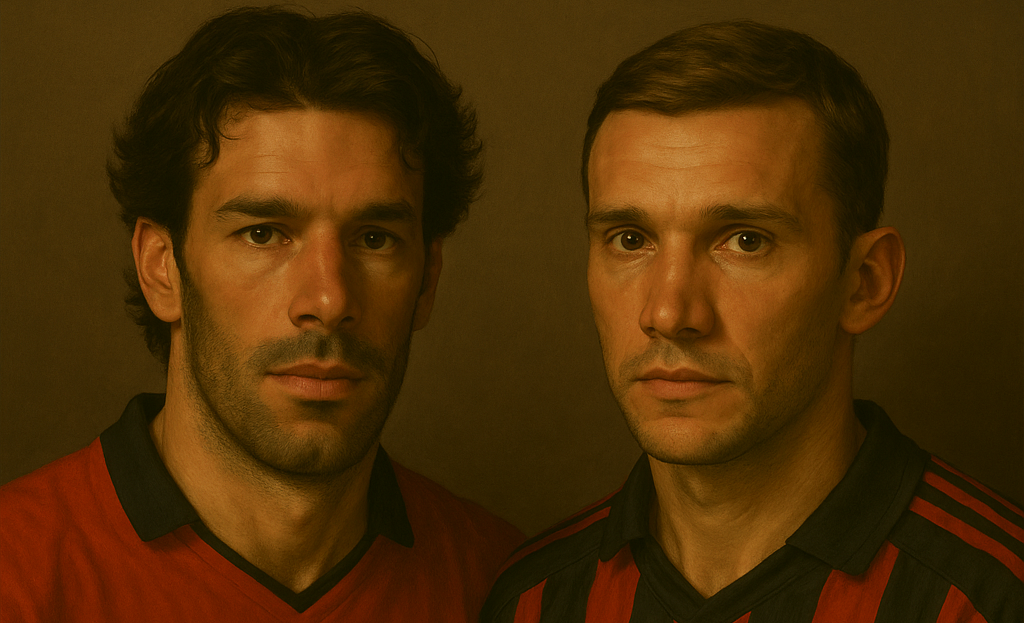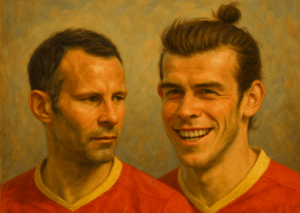
The GOAT of the Early 2000s Strikers?
In the early 2000s, two great strikers reigned at the pinnacle of European football. One was a cold-blooded predator who never missed an opportunity inside the penalty box. The other was a complete forward who dominated the entire pitch with explosive speed and perfect technique. The Netherlands’ ‘goal machine,’ Ruud van Nistelrooy, and Ukraine’s ‘Wind from the East,’ Andriy Shevchenko. The rivalry between these two players went beyond a simple battle for the top scorer title; it posed a fundamental question about what the ideal model for a 21st-century striker should be.
This article, from the perspective of 2025, aims to put an end to this long-standing debate through a comprehensive analysis that covers not only their entire playing careers but also their current roles as a manager and an administrator.
1. Analysis of Playing Style: A Clash of the ‘Poacher’ and the ‘Complete Forward’
Ruud van Nistelrooy: The King of the Penalty Box
Van Nistelrooy is often called a ‘Poacher’ or a ‘fox in the box.’ His play is summarized by his intelligent movement in front of the goal, his almost supernatural ability for positioning, and his concise, accurate one-touch finishing.
However, the ‘poacher’ label doesn’t fully capture his versatility. The fantastic solo dribbling goal he scored against Fulham in 2003 is an example that proves his outstanding ball control and power. The fact that he was both the top scorer and the top assist provider in the 2001-02 Champions League season shows his link-up play ability and unselfish side.
He was the pinnacle of a specialist, a player who proved his worth by completely dominating a specific area.
Andriy Shevchenko: The Complete Forward of Modern Football
Shevchenko is regarded as the epitome of a ‘Complete Forward.’ He possessed nearly every skill required of a striker at the highest level. His attacking options were diverse, including explosive speed that could break through defensive lines, powerful and accurate shooting with both feet, excellent aerial ability, and intelligent play to link up with teammates.
He was not a striker isolated at the front but a modern forward responsible for both the beginning and the end of an attack. During his time at Dynamo Kyiv, under the rigorous training of manager Valeriy Lobanovskyi, he grew beyond being a mere goalscorer into the tactical core of the team.
2. A Comparison in Numbers: What the Records Tell Us
Career Statistics Comparison
| Category | Ruud van Nistelrooy | Andriy Shevchenko |
|---|---|---|
| Total Appearances | 531 | 704 |
| Total Goals | 334 | 342 |
| Total Assists | 74 | 99 |
| Goals per Game Ratio | 0.63 | 0.49 |
National Team Record Comparison
| Player’s Name | National Team | International Appearances | International Goals |
|---|---|---|---|
| Ruud van Nistelrooy | Netherlands | 70 | 35 |
| Andriy Shevchenko | Ukraine | 111 | 48 |
UEFA Champions League Record
| Player’s Name | UCL Appearances | UCL Goals | Goals per Game | UCL Top Scorer |
|---|---|---|---|---|
| Ruud van Nistelrooy | 73 | 56 | 0.77 | 3 times |
| Andriy Shevchenko | 100 | 48 | 0.48 | 3 times |
3. Moments of Glory: Peak Years and Trophies
A Comparison of Their Peak Years: The Moments They Ruled Their Leagues
- Van Nistelrooy: The Manchester United Era
In the 2002-03 season, he scored 25 goals in the Premier League, winning the Golden Boot and being named the ‘Premier League Player of the Season.’ Thanks to his performance that season, Manchester United lifted the league trophy. - Shevchenko: The AC Milan Era
In the 2003-04 season, he became the Serie A top scorer (Capocannoniere) with 24 goals, bringing AC Milan its first Scudetto in five years. Based on this performance, he was awarded the Ballon d’Or in 2004, the highest individual honor for a footballer.
Honors Comparison: Who Won More Glory?
| Award Category | Ruud van Nistelrooy | Andriy Shevchenko |
|---|---|---|
| League Titles | 5 (2 Dutch, 1 English, 2 Spanish) | 7 (5 Ukrainian, 1 Italian, 1 English FA Cup) |
| Domestic Cups | 2 | 4 |
| UEFA Champions League | – | 1 (2002-03) |
| Ballon d’Or | – | 1 (2004) |
| League Top Scorer | Top scorer in 3 different leagues | Top scorer in 2 different leagues |
| Champions League Top Scorer | 3 times | 3 times |
4. Life After Playing: Where Are They in 2025?
Manager Ruud van Nistelrooy’s Challenge
Van Nistelrooy chose the path of a coach after retirement. He was appointed manager of his former club PSV’s first team and led them to victory in the KNVB Cup and the Johan Cruyff Shield. However, he has yet to achieve clear success in subsequent spells as interim manager of Manchester United and manager of Leicester City.
Administrator Andriy Shevchenko’s New Path
Shevchenko also experienced life as a manager, but his choice was the path of an administrator rather than one on the pitch. In January 2024, he was elected president of the Ukrainian Association of Football (UAF) and is working to develop his country’s football during a difficult time of war.
Final Verdict: The Legacy of Two Giants Who Defined an Era
The answer to ‘who was greater’ ultimately depends on what values you consider more important.
The Case for Van Nistelrooy: The Aesthetics of Efficiency
He will be remembered as the most efficient and ruthless master of the penalty box in modern football history. He was a craftsman who honed the striker’s primary virtue—scoring goals—to its absolute limit. If you had to pick just one player to guarantee a goal inside the penalty box, many would choose Van Nistelrooy without hesitation.
The Case for Shevchenko: The Value of Completeness
He will remain the epitome of a complete forward who combined explosive athletic ability with versatility. He was the symbol of a legendary club, AC Milan, and his individual glory reached its zenith with the Ballon d’Or. If you want a dynamic and versatile forward who can change the course of a game on his own, Shevchenko could be the answer.
The two players deserve to be placed side-by-side in the pantheon of football as symbols of different types of greatness, rather than being ranked for superiority. Their legacy, beyond records and trophies, will remain an eternal story that proves the diversity and beauty of the sport of football.




